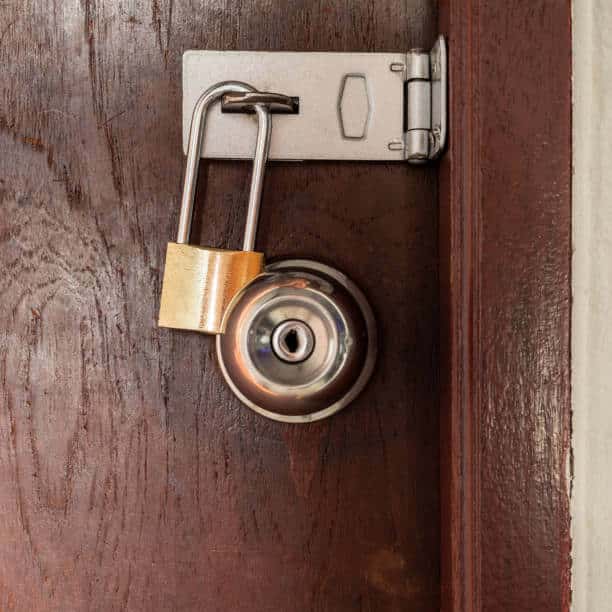Installing a padlock on a bedroom door can provide an extra layer of security and privacy. Whether you want to secure your personal belongings or keep unwanted guests out, a padlock can be a simple and effective solution. In this step-by-step guide, we will walk you through the process of ‘how to install a padlock on a bedroom door. From measuring and marking the placement of the padlock to testing and making adjustments if needed, we’ve got you covered. So let’s get started!
Why Install a Padlock on a Bedroom Door?
There are several reasons why you might want to install a padlock on your bedroom door. Firstly, it can provide added security, especially if you live in a shared living space or have valuable items in your room. A padlock can act as a deterrent for potential intruders and give you peace of mind knowing that your belongings are safe.
Secondly, installing a padlock on your bedroom door can enhance your privacy. If you have roommates or family members who frequently enter your room without your permission, a padlock can serve as a clear signal that you value your privacy. It can also prevent accidental interruptions when you are engaged in personal activities or simply need some alone time.
Lastly, a padlock on your bedroom door can be useful for parents who want to keep young children out of certain areas. It can prevent toddlers from accessing hazardous items or entering off-limits rooms. Overall, installing a padlock on a bedroom door is a practical solution that can provide security, privacy, and peace of mind.
Tools and Materials Needed for the Installation
Before you begin installing a padlock on your bedroom door, you will need to gather the necessary tools and materials. The list of supplies you’ll need is as follows:
- Padlock: Choose a padlock that is suitable for your needs. Take into account elements like size, durability, and quality of security.
- Drill: A power drill will be required to create holes for the padlock latch and strike plate.
- Drill Bits: Depending on the size of the padlock hardware, you may need different drill bits. Make sure you keep a variety of sizes available.
- Screwdriver: You will need a screwdriver to attach the padlock latch and strike plate to the door.
- Measuring Tape: Accurate measurements are crucial for installing the padlock properly. A measuring tape will help you determine the correct placement.
- Pencil: Use a pencil to mark the placement of the padlock hardware on the door.
- Screws: The padlock latch and strike plate will need to be secured to the door using screws. Ensure that the screws you have are the right size and kind.
- Safety Glasses: It is important to protect your eyes while drilling and handling tools. Throughout the installation process, keep your glasses on.
- Dust Mask: If you are drilling into a wooden door, it is advisable to wear a dust mask to avoid inhaling wood particles.
Installation Process
Step 1: Measure and Mark the Placement of the Padlock
The first step in installing a padlock on a bedroom door is to measure and mark the placement of the padlock hardware. Start by deciding where you want the padlock to be installed on the door. It is recommended to position it at a height that is convenient for you to reach and use comfortably.
Using a measuring tape, measure the distance from the edge of the door to the center of the padlock latch. Mark this measurement on the door using a pencil. Next, measure the distance from the edge of the door to the center of the padlock strike plate. Mark this measurement as well.
Make sure that the marks for both the latch and strike plate are level and aligned properly. Double-check the measurements to ensure accuracy. Once you are satisfied with the placement, you are ready to move on to the next step.
Step 2: Prepare the Door for Installation
Before installing the padlock hardware, you need to prepare the door by creating holes for the latch and strike plate. Using a drill and an appropriate drill bit, carefully drill a hole for the padlock latch at the marked location. Make sure the hole is deep enough to accommodate the latch.
Next, drill a hole for the padlock strike plate at the marked location on the door frame. Again, ensure that the hole is deep enough to accommodate the strike plate.
After drilling the holes, use a chisel or a utility knife to create a recess for the strike plate. This will allow the strike plate to sit flush with the door frame. Be cautious not to remove too much material and take your time. Test the fit of the strike plate to ensure it sits properly in the recess.
With the door prepared, you are now ready to install the padlock hardware.
Step 3: Install the Padlock Latch
In this step, you will install the padlock latch on the door. Begin by inserting the latch into the hole you drilled earlier. Make sure the latch is oriented correctly, with the curved side facing the edge of the door.
Secure the latch to the door using the provided screws. Use a screwdriver to tighten the screws, but be careful not to overtighten and strip the screw holes. Test the latch by turning the knob or lever to ensure it operates smoothly.
Step 4: Install the Padlock Strike Plate
Now it’s time to install the padlock strike plate on the door frame. Position the strike plate over the hole you drilled earlier, ensuring that it aligns with the latch on the door. Mark the outline of the strike plate on the door frame using a pencil.
Using a chisel or utility knife, carefully chisel out the marked area on the door frame to create a recess for the strike plate. To make sure it fits properly, take your time and be precise.
Once the recess is created, align the strike plate with the hole and attach it to the door frame using the provided screws. Use a screwdriver to secure the strike plate, making sure it sits flush with the door frame. Test the padlock by inserting it into the latch and ensuring it engages with the strike plate smoothly.
Step 5: Test the Padlock and Make Adjustments if Needed
With the padlock hardware installed, it’s time to test the functionality of the padlock. Insert the padlock into the latch and ensure it locks and unlocks smoothly. Test the door by opening and closing it to make sure the padlock does not interfere with its operation.
If you encounter any issues or the padlock does not function as expected, you may need to make some adjustments. Check if the latch and strike plate are properly aligned and adjust if necessary. Also, make sure the padlock is the correct size for the door and that it is installed securely.
Additional Tips for Maintaining and Using a Padlock on a Bedroom Door
Once you have successfully installed a padlock on your bedroom door, there are a few additional tips to keep in mind:
- Lubricate the padlock regularly: Apply a small amount of lubricant to the padlock mechanism to ensure smooth operation. This will prevent rust and keep the lock working properly.
- Keep spare keys in a safe place: If you have multiple people accessing the room or in case you lose the key, it’s a good idea to have spare keys stored in a secure location.
- Communicate with others: If you share the living space with others, make sure to communicate the purpose and importance of the padlock. This will avoid misunderstandings and ensure everyone respects your privacy.
- Use the padlock responsibly: Remember to lock the padlock when you leave the room and unlock it when you enter. This will prevent accidental lockouts and unnecessary wear on the lock mechanism.
Conclusion
Installing a padlock on a bedroom door can provide both security and privacy. By following this step-by-step guide, you can easily install a padlock on your bedroom door and enjoy the benefits it offers. Remember to gather all the necessary tools and materials, measure and mark the placement of the padlock, prepare the door, install the padlock latch and strike plate, and test the padlock for proper functionality. With a little effort and attention to detail, you can enhance the security and privacy of your bedroom.
Frequently Asked Questions
1. Can I install a padlock on any type of bedroom door?
Yes, you can install a padlock on most types of bedroom doors, including wooden, metal, and composite doors. However, the installation process may vary slightly depending on the door material.
2. Do I need any special skills to install a padlock on a bedroom door?
No, installing a padlock on a bedroom door does not require any special skills. With basic DIY knowledge and the right tools, you can easily complete the installation.
3. Can I remove the padlock later if I don’t need it anymore?
Yes, you can remove the padlock from your bedroom door if you no longer need it. Simply unscrew the latch, strike the plate, and fill any holes with wood filler or putty.
4. Are there any alternative security options for bedroom doors?
Yes, there are alternative security options for bedroom doors, such as electronic keyless locks or smart locks. These offer convenience and additional features but may be more expensive than a traditional padlock.
5. Can I use the same padlock for multiple doors in my house?
Yes, you can use the same padlock for multiple doors in your house as long as the dimensions and specifications of the doors are compatible with the padlock.
6. Can I install a padlock on a bedroom door with glass panels?
While it is possible to install a padlock on a bedroom door with glass panels, it may compromise the aesthetic appeal and functionality of the door. Consider alternative security options for doors with glass panels.
7. How often should I replace the padlock?
The lifespan of a padlock depends on factors such as usage, quality, and maintenance. Inspect the padlock regularly for signs of wear or damage, and replace it if necessary.
8. Can I rekey a padlock to use a different key?
Some padlocks can be rekeyed to use a different key. Check the manufacturer’s instructions or consult a locksmith for guidance on rekeying your specific padlock.
9. Is it legal to install a padlock on a bedroom door in rented accommodation?
Laws regarding padlock installation in rented accommodation may vary depending on your location and the terms of your lease agreement. Before making any changes, speak with the property management company or your landlord.
10. Can I use a combination padlock instead of a key-operated padlock?
Yes, you can use a combination padlock as an alternative to a key-operated padlock. Combination padlocks offer the convenience of not needing a physical key, but they should be regularly reset to maintain security.


